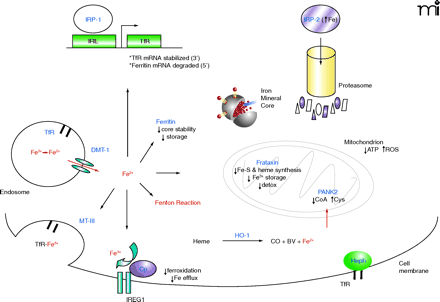
- Institution: Stanford Univ Med Ctr Lane Med Lib/Periodical Dept/Rm L109
- Sign In as Member / Individual
Iron Dysregulation and Neurodegeneration: The Molecular Connection

Intracellular fate of ferrous iron. The uptake of iron in the ferric form (Fe3+) is mediated by the transferrin receptor (TfR) and the reductase present in acidified endosomes converts Fe3+ to the ferrous form (Fe2+) before transport into the cytosolic space by divalent metal transporter-1 (DMT-1). The resultant Fe2+ within the labile iron pool (LIP) either: 1) activates the regulatory iron regulatory protein/iron regulatory element (IRP/IRE) system, 2) gets sequestered by chaperones or storage proteins [such as ferritin, metallothioneins (MTs), and frataxin], 3) reoxidizes into Fe3+ and effluxes out of the cell via Cp and IREG1, or 4) participates in iron-catalyzed reactions to generate reactive species [e.g., pantothenate kinase 2 (PANK2)-deficient oxidation of cysteine residues]. Additionally, Fe2+ can be liberated from free heme groups to contribute to the LIP. Heph; hephaestin, a membrane-bound protein homolog of Cp.


